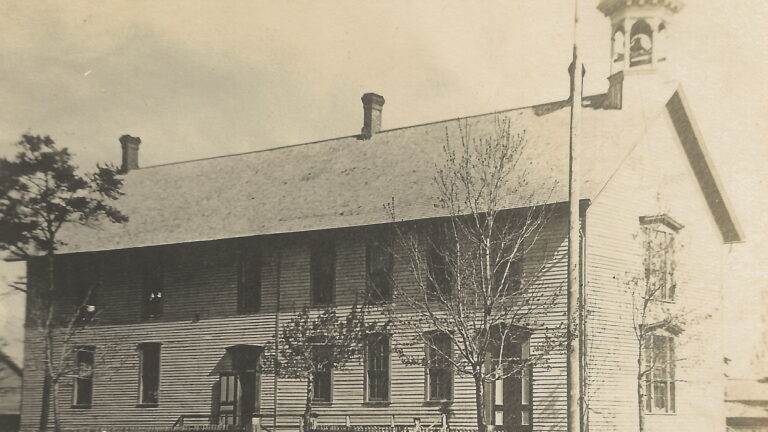This story has two parts.
The first part is by Julie R. Applegarth, June 1989.
The second part is an article that appeared in the Oscoda Press by editor Will McGillivray. It was titled, Oscoda and Au Sable Wiped Out by Fire. The article was preserved in the book “Log Marks” by Neil Thornton.
Part One:
On July 11, a warm summer day in 1911, the neighboring cities of Oscoda and AuSable (Michigan) burned to the ground in what has been called the “most devastating fire in the history of Michigan”. Both cities were constructed entirely of wood, due to the heavy influence of the lumber trade in those years. Not a single concrete sidewalk or building could be found, which made the communities perfect bait for the hungry, rapid flames.
A forest fire had been hovering outside AuSable for three days prior to the tragedy, but the townspeople went about their business as usual, confident that their city would not be burned. On July 11 sudden fifty mile-per-hour winds swept the fire into AuSable, taking its inhabitants by surprise. Meanwhile, one mile west of Oscoda a passing locomotive threw sparks which ignited, spread quickly, and swept across a river valley destroying over three-fourths of the city of Oscoda. This fire united forces with the one already burning in AuSable, and drove the townspeople before it, running like a stampede of cattle to escape its wrath. Within two hours only twenty houses were left standing in Oscoda and only four buildings remained in the main portion of AuSable.
For the people living there July 11, 1911, and the days and weeks following were nightmares. Some of those who attempted to save precious belongings were either caught in the flames or forced to abandon them and run for shelter. Shelter from the fire was found only in large expanses of sand and dunes, or in Lake Huron. Most people waded out into the cold, rough lake until they were neck-deep, holding children and the few possessions they managed to rescue over their heads. Even dogs, chickens, and cats were driven to the water. But even there the heat of the fire was tormenting, and people were forced to splash water on their heads and necks respectively.
Luckily a lumber boat that was docked at AuSable during the time of the fire carried away many men, women, children, and animals south to the safety of East Tawas and Port Huron. Mr. Chase S. Osborn, governor of the State of Michigan, appealed to the citizens of Michigan to contribute common necessities, clothing, food, and money to help assist the survivors of the fire. Railway companies transported the refugees to the nearest towns, and East Tawas residents gladly gave up their beds to the exhausted people, many of whom had been separated from their families and friends during the panic of the fire.
Most of the residents of AuSable and Oscoda had to start their domestic lives over from scratch after the fire. Many moved permanently to East Tawas, Bay City or Port Huron and were eventually able to find jobs, set aside some savings, build houses, and live normally once again.
Not only did the fire take the homes and possessions of AuSable and Oscoda residents, it destroyed the economic livelihood of the cities as well. The entire stock of the H. N. Loud and Sons lumber company was devastated, along with their mills and thousands of acres of lumber. The Louds were one of many families that moved to Bay City after the disaster, and later they migrated to Oregon to try their luck on the lumber business once again. The railroad companies also suffered heavy loss. Due to the intense heat, the rails were warped and buckled beyond repair in certain areas.
Despite the immense destruction of the fire, there were a few trinkets and possessions that somehow escaped the flames. Silver vases, which had been buried at the first warning of fire, survived. Ceramic plates were also spared by the flames, although other substances were melted and crusted onto them in places. Two such plates are on display in the museum of the Iosco County Historical Society in East Tawas.
There were also a few “freak finds”: mysteries of the fire that remain unsolved to this day. An example is the photograph that was found standing on a piano in the Swanson home. Although the picture frame was damaged, the photo itself was not even scorched while the piano and everything else in the house was destroyed! Also found, next to a mass of silverware which had been melted together by the flames, was a hand-painted cream jar which showed no trace of the fire.
Destruction of both cities was nearly complete apart from the few objects (some of which are mentioned above) and the mere twenty-four buildings that escaped the flames. Fortunately, only five people died in the fire of 1911, but those who survived, and their descendants, will remember the tragedy for years to come.
Part Two:
Oscoda and Au Sable Wiped Out by Fire
“Oscoda – Fire originating in adjacent forests and from sparks said to have been thrown by the locomotives of both the AuSable & Northwestern and the Detroit & Mackinac railway lines, devastated the twin towns of Oscoda and AuSable and that part of the community known as AuSable township, Tuesday, July 11.
Business blocks, mills, factories, and residence houses were destroyed to the number of about 600. Five lives were lost in the disaster: Francois Clairmount, an aged musician; William Batts, yardman at the Hotel Elliott; Samuel Rosenthal, merchant; Jacques Lavoie, box maker, who died of burns received, and an unidentified peddler. Only for the timely arrival of the steamer Niko, of the Edward Hines fleet, Captain Meyer, of Tonawanda, the loss of live would have been appalling.
Two hundred and eighty persons, most of them women and children, were hemmed in on the lake shore, to which wings of fire had already spread on the north and south with the van of the conflagration moving down between. All but strong swimmers would undoubtedly have perished had not the boat arrived.
The forest fire which had been burning since the preceding Sunday in the neighborhood of the new chemical plant was the cause of the burning of two houses in West AuSable early in the day. Sparks from the engine of the train known as the “Lincoln Stub” are said to have been responsible for the fire which burned the H. M. Loud Sons’ yards and plant. The big fire which bore down on Oscoda at four in the afternoon in a great wall of flame, started near the AuSable and Northwestern tracks at the Barlow farm.
Within five minutes, twenty houses were ablaze on Main Street, and when it became evident that Oscoda was doomed, men ran up and down urging the women and children to hurry to the Loud Company’s south dock, at which the steamer “Niko” had just arrived. In the meantime, residents of “Shore Town” were flocking to the junction of the docks at the water’s edge. When the first crowd of women and children reached the boat at the end of the pier, men already on board were crying to the captain to “pull out”. Eli Herrick, Peter McPhail and others of Oscoda and Charles Jahraus of Tawas City, stood by the lines declaring that they must not be thrown off until all who could be saved were taken on board.
When the boat left the dock, her cabins were on fire fore and aft, and a disastrous panic was narrowly averted. The refugees could not be landed at Tawas, on account of the heavy sea, and the boat finally docked at Bay City.
With the fire, which had entered at the west and early in the day, quenched AuSable seemed safe from the devastation underway in Oscoda, until the wind changed at 7 o’clock.
Turning like a horse at the starting line, the flames set a terrific pace from the north to the south limits, the buildings sloughing before them as babbit melts and settles in a heated crucible. The inhabitants scurried before it like a herd of cattle amuck.
Far out on the sands of the shore they ran helter skelter, void of dignity, all but one. Judge Connine, of the Iosco County Circuit Court, was the last in retreat. Appearing and disappearing in the front volumes of smoke, he walked with an extended stride, but even in the vortex, dignified. On the sands, in the cold north wind, social caste was lost and rich and poor huddled together until sunrise, in mutual discomfort.
When the sun rose Wednesday morning, there was no one alive near the scene of the calamity but shuddered at the thought that hundreds of their neighbors had met a fearful death. When nightfall came and only four bodies had been found, there was a general feeling of relief, mingled with sorrow for the unfortunate ones.”
Personal Note from June Pelo:
My mother’s sister and family were burned out of their home in Oscoda by this fire. I remember my cousins telling me that their father grabbed some silverware and other items and buried them in the sand on the beach just before they all ran and stood in the water up to their necks with the air full of smoke and flames from the fire. They never recovered the items that were buried. After the fire the family moved to a farm in Alabaster, a city south of Tawas.
My mother was born in AuSable where the family lived in a house owned by the lumber company for which my grandfather worked. JP





